-
Author
Jessica Hemmings -
Date
12 Aug 2020
Essay
Thoughts from a Slow Internet in Spanish Lockdown
Issue One: Ockham Lectures Pocket Edition
“The word is not the thing; word and thing have each their own way.”1
I have fallen in love with writing again. We never particularly fell out of love, but I had reached that stage of feeling things were driven more by obligation than desire. Words have been my materials for quite some time now. When asked if I have time to weave my answer has long been tinged with guilt – as though I should miss it more than I honestly do. Studying weaving led me to words, and has kept me close to textiles. But no – even now, I do not much miss my own weaving. At times I have wondered if it is because of my peripatetic life. Books are heavy enough to pack – a loom shipped from country to country feels very cumbersome.
In truth, my words have always felt a little more needed than my weavings ever did. There are more practitioners who deserve well-considered writing about their craft than there is a need for my textiles in the world. But I had started to take those words for granted. Then, I travelled with little notice into another country, the night before the borders closed, to be near my mother. No chance to bring a loom, even if I had wanted to. Not much time even to pack books, apart from a select few. Now, several months into the lockdown in Spain which began on March 15, restrictions remain understandably tight. But I see that I’ve carried my words with me without even needing to pack them.
Now the world cannot travel – and I am a traveller. Like many others, I now live in enforced solitude. On the latter point I suspect, on a good day at least, I might be in my element. I am an only child, adept at role-playing my enjoyment of social engagements. Research has shown that it may be incorrect to think that autism affects young men more than young women. Instead autism is diagnosed in far more young men because young women are much better at mirroring social expectations.2 I could add that individuals who choose to spend free time either long distance running or underwater are unlikely to be big talkers.
I am also English – if you subscribe to the thinking that you are something because that is what your parents are. I have spent very few years of my life in England. But my parents are English. Somehow, I turned out, at least when it comes to manners, to be very English without ever belonging in England; without ever belonging much anywhere. This does not create the sense of internal trauma I feel projected onto me from those who do have a clear sense of belonging and presume that I live in a form of perpetual mourning.
The late writer Yvonne Vera, speaking of the economic crisis in her country in 2002 and her decision to step down as director of the National Gallery of Zimbabwe, Bulawayo, said that food and shelter were all she required to be able to write.3 But she also differentiated herself from other fiction writers by explaining her need to be in Zimbabwe to write about Zimbabwe. She felt she could not project her imagination from afar and write about a place she did not currently inhabit. I am not a writer of fiction, but I write about physical work that I have had the opportunity to experience first-hand. Maybe this is another version of Vera’s need to be grounded – to be in physical proximity of the content of your words.
Along with most education globally, the university where I work has moved online. Some of this works. PhD supervision – especially for projects that are at the stage of editing reflections about practice – continue in part because these are relationships already in motion. We draw on existing rapport built in person and can hold onto that for the next few months. Maybe. Probably not forever. Out of seven PhD candidates I have contact with, five use English as a second language. Despite their fluency (which I could never begin to claim), the potential for misunderstanding is real. Nuance is flattened. Without body language to correct our miscommunications, we are unlikely to be communicating online as effectively six months from now as we do today.
In the summer of last year, I participated in a talk with Ezra Shales, then a Fulbright Fellow with Högskolan för konst och design (HDK) at the University of Gothenburg (where I work), and Nina Due, director of the Röhsska Museum. We called the talk “Exhibition Making: Perspectives from a Curator, Historian and Critic” and I found myself reflecting on a book I wrote a few years ago, Warp & Weft (2012). A number of people had told me that the book would have made a wonderful exhibition. I know that what they were also saying was that it had not made for such a good book. Their comments are accurate; it is not a very good book. It could have become an interesting exhibition. As a book, it is a compilation of shorts spurts of writing better suited to the magazine articles I had far more experience churning out at the time.
The lesson has left me wondering how to know when
one idea will be better off as an exhibition while another is better suited to writing. I confidently wrote about the portability of textiles in the introduction to a book I edited called Cultural Threads (2015). But it was not until I organised a travelling exhibition (despite the absence
of funding) inspired by my work on the book that I really understood what ‘portability’ could mean. I called the exhibition Migrations and it took many journeys, including Dublin to Sydney quite literally on my lap. But where digital image files allowed for trimming and compression onto book pages, the exhibition content was stubbornly honest in its dimensions. Material was bigger and smaller, thicker and thinner, than my editorial eye had known from photographs.
Curating the travelling exhibition taught me lessons that compiling the book had never brought to mind. For example, I had to explain to the artists involved that I could not afford insurance for the artwork we shipped. In response, many generously suggested that instead of
a one-off piece they lend printed textiles which already existed as multiples. If these were sent by normal post and lost, there would be more of the same yardage in their studios. Printed textiles, something I can honestly admit I was not often drawn to before, took on a whole new value in my eyes.
Because Cultural Threads was an editorial project, I saw that my network expanded twelvefold thanks to the contributors’ own networks. While it is unusual for writers to work in collaboration, the default setting for editorial work is collaborative. In fact, the editorial eye and ear is perhaps the uncelebrated hero of networked writing. But editorial work and its distant cousin co-authorship are processes that can be messy. When I first co-authored an academic article, I joked never again.4 The article began as a conference panel that had run surprisingly well; from that we bolted together our individual papers in a roughly sutured whole that had been, I suspect, far more logical in person than the final published writing. More recently I have co-authored articles by way of annotating the transcripts of dialogues.5 Here the fit feels more comfortable. None of these articles began online. Instead they are writing that was polished and finished online but, crucially, the original conversations occurred in person.
Writing from Spain today, I have a newfound respect for the remarkable flexibility that words allow. I can shape and send them out into the world even here on a slow internet connection. Thinking of possible teaching content that could be delivered online, I remembered that a lecture I gave in Johannesburg a few years ago had been recorded. I sent a request to colleagues in South Africa who sent the video link to New Zealand (where my Welsh web designer is with his daughter) for upload to the internet, so I could then log on and edit in Spain. I am old enough to still marvel that this is a solution. While I stay within the same square metres I have walked (and run) for months now, such journeys online are an option.
As I battle with my slow internet connection, I am reminded that for many globally my minor inconvenience is their norm. This is something
I knew but – like the dimensions of the artwork in the Cultural Threads book – I had not lived. There are individuals today who are not online. A recent newsletter from Threads of Life (a textile gallery and workshop based in Ubud, Bali) noted that “with few having laptops, there is very little work from home, so we are slowly figuring out how to remain productive while minimising interaction.”6 As the world adjusts
to the restrictions and limitations of our current moment the internet is a lifeline. For some. But it has never been a resource available to all. The late American science fiction writer Ursula Le Guin’s concept of handmind feels relevant as I write today.
'Nothing we do is better than the work of handmind. When mind uses itself without the hands it runs the circle and may go too fast; even speech using the voice only may go too fast. The hand that shapes the mind into clay or written word slows thought to the gait of things and lets it be subject to accident and time.'7
If we follow Le Guin’s idea of handmind, I wonder how long we can exist on a diet of online words when we need to
be, if not making, then at least in the presence of making?
I marvel at what is possible to do with words from this unanticipated place of today, but I also question how long we can teach our students online. How long can we fuel ourselves with trips to online exhibitions?
Each day I receive online exhibition announcements
– alternatives to the cancellation of public events, well-intentioned distractions. These online links make me nervous about the impact our current moment will have, most particularly for craft. While we have certainly slowed our bodies down, it has not been with intent. In
2010 I reviewed an exhibition called ‘Sitting & Looking’
at the Dovecot Studios in Edinburgh, Scotland, curated by furniture designers Jim Partridge and Liz Walmsley. The pair explained, “Slowing down the viewing experience is part of our curatorial plan.” In the review I quipped, “as long as it isn’t our Internet access, anything ‘slow’ seems to enjoy the stamp of cultural approval these days”, but concluded, “what this exhibition does so well is provide a powerful reminder for those of us engaged with the peripheries of making (consumption and admiration, rather than production) that talking about slowing down to sit and look is very different to doing it.”8 I come back to this thinking now, aware that we have all been forced, rather than chosen, to slow down in isolation.
Our current pace of slow is not the same as the invitation
to sit and look that Partridge and Walmsley conceived for their exhibition frequented by presumably harried visitors. Re-reading my review from 2010 (when the download was eventually complete), I noticed that I had written that “my gallery visit began as many do with a harried dash to the venue”. Much more recently, I visited Icelandic artist Hildur Bjarnadóttir’s exhibition ‘Cohabitation’:
'A sound piece, ‘Belonging’, recording a bird Bjarnadóttir noticed flying in circles above Thufugardar also accompanies ‘Cohabitation’ [...] The distinctive sound, which is made by the bird’s tail feathers, isn’t immediately suggestive of the natural world and the work plays only intermittently on a surround speaker system which makes its location impossible to pin point. Hasty visitors like myself miss out entirely – just punishment for taking too little time to listen and wait.'9
I wonder now if I will be a slower, or a hastier, visitor to the next exhibition I am able to see in person?
Though we all find different ways to reconcile our responses to the particulars of our curtailed physical environments, our restricted pace is not chosen. Instead our current moment uses a curious absence of discipline because it is not elected. That makes me suspect, in the long term, that effects are likely to be temporary. Are we building new skills as we live, slowed to a crawl – in person and for some online – that we will bring with us into the future? Or are we all stretched taut like rubber bands, feeling ready to snap (I certainly have those days), but also desperate to ping back into the same shape we inhabited prior to lockdown? Because if we snap back just as we were before, craft will suffer again: from our lack of time; our lack of attention and concentration; ultimately our lack of respect.
I have long suspected that if textiles in particular struggle for broader recognition in the art world it is in part because they are so damn difficult to photograph – so much vanishes when images are accessed online. T’ai Smith notes the opposite with regards to the benefits the woven textile designs by Bauhaus weavers enjoyed.10 I don’t disagree with Smith – detailed woven textile design can flourish in micro photography. But I recently allowed myself to have a grumble at the floor plinths used in the exhibition ‘Weaving beyond the Bauhaus’ at the Art Institute of Chicago.11 Here deep plinths were used to keep viewers at a safe distance from the woven Bauhaus textiles, without needing to resort to Perspex or little ropes. The works were kept safe, but at the expense of anyone getting close enough to really see and thus appreciate their subtle beauty.
The Chicago exhibition taught me other lessons about the trickery of photography. I had the good luck to visit the exhibition on two separate occasions in 2019. The review I wrote was on the grumpy side, and my gut was unwavering about what I wrote. Now the review is in print and the accompanying exhibition images published alongside my writing look great. What was her problem? I can hear readers wonder – the exhibition looks good in the photos. My point, I think, is that photographs are another world. They create an alternative reality – at times closer to how the experience felt in person, but on other occasions almost unrecognisably different. The images which accompany my review do not convey the walk you take through the Art Institute of Chicago – down the dark steps and into the shoved-off corner of the textile gallery. Instead they present a self-enclosed reality devoid of context, where everything looks just fine.
In April the Financial Times newspaper published a review of the Donald Judd exhibition currently installed at the closed MoMA in New York City subtitled “an exhibition that’s better online?”12 Prior to the museum’s closure, physical entry to the exhibition had been controlled for the benefit of the viewing experience (“Simple art needs plenty of breathing space, and crowds viewing Donald Judd’s delicate hulks needed to be kept sparse.”) But all that is in the past. With the exhibition now only accessible online, the reviewer acknowledges that online viewing means “you miss the sculpture’s mute bulk and unyielding presence” but decides that the format benefits the work: “It turns out that a massive Donald Judd retrospective in an empty museum is salutary for his art, and for the public.” The observation offers us a provocative challenge to exhibition norms, but I can think of little craft that aspires to be as “antiseptic” as Judd desired of his work.
Writing in March for The Irish Times, Gemma Tipton reviewed the current online offerings of some of the most celebrated art museums in the world. Tipton determines a mental gap that exists with online viewing: 'we commit to going to a gallery. The journey to it, its entrance hall, the admission charge (if you’re almost anywhere but Ireland), all are part of a process of refining and focusing your mind, until you’re truly ready to give time to some of the world’s greatest masterpieces. And face it, if virtual viewing really was even better than the real thing, the advent of the internet would have closed galleries down years ago. No, visiting a museum is a physical as well as an intellectual pursuit.'13
The lesson that may now be needed is one of discernment: deciding what can meaningfully translate online, and what simply cannot. For craft practices which focus on the material qualities of weight, or texture, photography is no substitute. The Donald Judd reviewer wrote from a comparative perspective. By virtue of having had an initial, first-hand experience to draw on, she was able to note what was lost, as well as gained, in online viewing. You get the sense that at least some of the museums Tipton writes about she too has visited previously:
'Galleries also direct attention. In the Uffizi, the heat of the city and smell of the nearby Arno add to the experience of being there. However, once inside, you can focus in on the acknowledged superstars, because they’re surrounded by thick clusters of fellow visitors. Via Street View, the gilt-framed images appear equal. I start to feel elements of video gaming, as I work out how to click through, to enter new galleries, tracking down a Caravaggio or a Leonardo; but once I hit on such a masterpiece, I get a strange sense of “so what”'.14
Tipton’s “so what” risk occurs even before we include those practices that focus as much, if not more, on interactions between people rather than materials. The still images that capture the values of Judd’s work to the extent that online viewing may be a boon for the current MoMA show are unlikely to communicate the values of socially focused craft practices. Claire Bishop in her now well-cited book Artificial Hells: Participatory Art and the Politics of Spectatorship (2012) says, “To grasp participatory art from images alone is almost impossible: casual photographs of people talking, eating, attending a workshop or screening or seminar tell us very little, almost nothing, about the concept and context of a given project.”15 Bishop is at pains to point out that the problem is not new – and she certainly was not writing in the midst of global lockdown when she acknowledged that in our time-poor lives, “Very few observers are in a position to take such an overview of long-term participatory projects.”16
Time and images. Perversely, we seem to have an excess of both on our hands currently. But they may not be quite the right kind. An enforced, curtailed, slowdown is not the same as an elected gear change. And while we continue to be inundated with online material – some of it exceedingly beautiful – it can flatter the antiseptic agendas of Donald Judd a good deal more than practices that emphasise the values of warmth, care or skill.
And those portable words I carried with me without thinking to pack? Today I have a backlog of work. Things I have seen and agreed, or intended, to write about are now like cut firewood, stacked and ready to use. I am crafting words in Spain from first-hand experiences held in my recent memory. Next door I can hear Rosario, my ninety-year-old neighbour. She is riding out this storm in her home, with her disabled son, who catches sight of me on the patio some days while I run on the spot. We share a rare laugh – he sees the oddity of running in place to be as comical as I do. But I cannot send Rosario kind notes of neighbourliness (even assisted by Spanish Google Translate). Here my portable words are of no use. Rosario never learnt how to read. Instead, I continue to climb the stairs and set my phone timer to run on the spot in a competition I refuse to lose – a game of stubborn repetition – while my body pines for the marathon I ran only a few months ago. Even then, as my mother and I changed planes in Singapore and cautiously moved through the heat sensors and health checks, we were already racing the virus.
Soon, too, my stack of firewood will run out. For me, no amount of online exhibition viewing, however well presented, is going to bridge the absence of seeing and being with physical work. This is even before we consider the community-building function that attending an exhibition provides a group of individuals (perhaps here our playing fields are all levelled to zero for the time being).
No one invited the moment we are living through. I imagine the time when restrictions do ease will bring with it a renewed appetite for being with others and being with materials. But my love affair with words and their portability cannot survive in isolation – my words are about stuff. Because, as Le Guin cautioned, “the word is not the thing”, my wood pile of thinking needs to be restacked by the physical things I write about. I am sure that I will be able to do that again. And I may stack my next woodpile a little higher than I had before, just in case. I think we need also to be wary of the inevitable suggestions that may emerge from this time: Should we do more online? Wasn’t it quite a good substitute? It certainly costs less to teach this way... No. Not unless you want to empty your woodpile for good.
--
Jessica Hemmings writes about textiles. She studied Textile Design at the Rhode Island School of Design, graduating with a BFA (Honors) in 1999 and Comparative Literature (Africa/Asia) at the University of London’s School of Oriental and African Studies, earning an MA (Distinction) in 2000. Her PhD, awarded by the University of Edinburgh in 2006, is published by kalliope paperbacks under the title Yvonne Vera: The Voice of Cloth (2008). She has taught at Central Saint Martins, Rhode Island School of Design, Winchester School of Art and Edinburgh College of Art. In 2010 she edited a collection of essays titled In the Loop: Knitting Now published by Black Dog and in 2012 edited The Textile Reader (Bloomsbury) and wrote Warp & Weft (Bloomsbury). Her editorial and curatorial project, Cultural Threads, is a book about postcolonial thinking and contemporary textile practice (Bloomsbury: 2015) accompanied by a travelling exhibition Migrations (2015-2017). Jessica is a member of the Editorial Board of Textile: the Journal of Cloth and Culture (Taylor & Francis) and Craft Research (Intellect). From 2012-2016 Jessica was Professor of Visual Culture and Head of the School of Visual Culture at the National College of Art & Design, Dublin. She is currently Professor of Craft & Vice-Prefekt of Research at HDK-Valand, University of Gothenburg, Sweden.
1. Ursula Le Guin, “Words/Birds. A Madrone Lodge text” in Always Coming Home (London: Grafton Books, 1985), p. 311.
2. Hannah Devlin “Thousands of Autistic Girls and Women ‘Going Undiagnosed’ due to Gender Bias”, The Guardian, 14 September 2018, (accessed 4 May 2020).
3. Yvonne Vera interviewed by Eric Beauchemin for Radio Netherlands, 2003, on YouTube (accessed 11 April 2020).
4. Betsan Corkhill, Jessica Hemmings, Angela Maddock & Jill Riley, “Knitting and Wellbeing”, TEXTILE, 12(1), 2014, pp. 34–57, DOI: 10.2752/ 175183514X1391605179433.
5. Jessica Hemmings & Birgitta Nordstrom, “How Do You Footnote a Smile? One Dialog about Two Extremes of Textile Research”, TEXTILE, 18(1), 2019, DOI: 10.1080/14759756.2019.1616460; Anthony Bumhira, Erica de Greef, Tandazani Dhlakama, Jessica Hemmings & Hayden Proud, “Material Matters in Paintings at
the End of an Era”, TEXTILE, 18(1), 2020, DOI: 10.1080/14759756.2020.1738318.
6. Threads of Life e-newsletter and website, 10 April 2020 (accessed 11 April 2020).
7. Ursula Le Guin, “Stone Telling: Part Two” in Always Coming Home, p. 175.
8. Jessica Hemmings, “Sitting and Looking” review, Crafts magazine, Sept./Oct. 2010, p. 70.
9. Jessica Hemmings, “Material Color”, Norwegian Crafts, 2018
10. T’ai Smith, “The Haptics of Optics: Weaving and Photography” in Bauhaus Weaving Theory: From Feminine Craft to Mode of Design (London: University of Minnesota Press, 2014), pp. 79–110.
11. Jessica Hemmings, “In Review: Weaving Beyond the Bauhaus”, Surface Design Journal, Spring 2020, pp. 54–56.
12. Ariella Budick, “Donald Judd at MoMA – An Exhibition that’s Better Online?”, 10 April 2020, Financial Times website, (accessed 10 April 2020).
13. Gemma Tipton, “Virtual Viewing: A Guide to Visiting Museums Online in the Age of Covid-19”, The Irish Times, (accessed 13 April 2020).
14. Ibid.
15. Claire Bishop, Artificial Hells: Participatory Art and the Politics of Spectatorship (London: Verso, 2012), Kindle loc. 148.
16. Bishop, Kindle loc. 157.
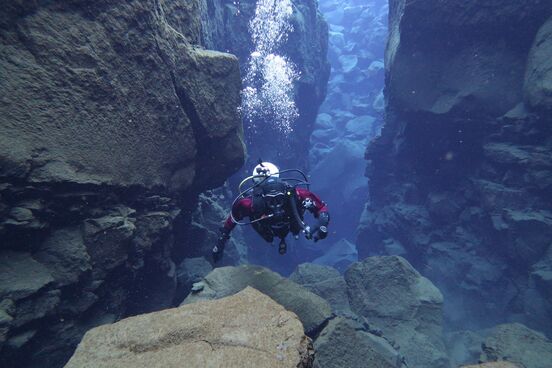
Jessica Hemmings, Silfra Fissure, Iceland, 2017.

Figure 5. Migrations exhibition installation view National College of Art & Design Gallery, Dublin, Ireland (April 30 – May 29, 2015). Featuring work from Toril Johannessen, Godfried Donkor, Mr Somebody & Mr Nobody, Dan Halter, Francoise Dupre
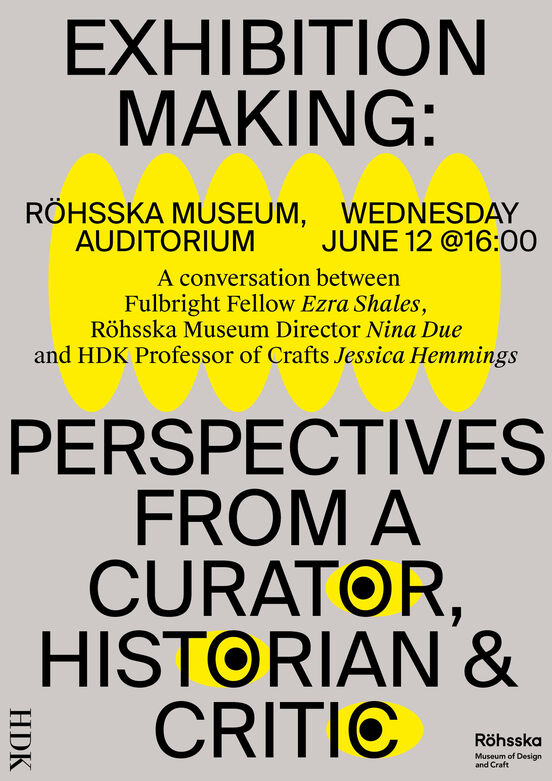
Figure 2. Exhibition Making poster (2019). graphic design: www.osvaldlandmark.com
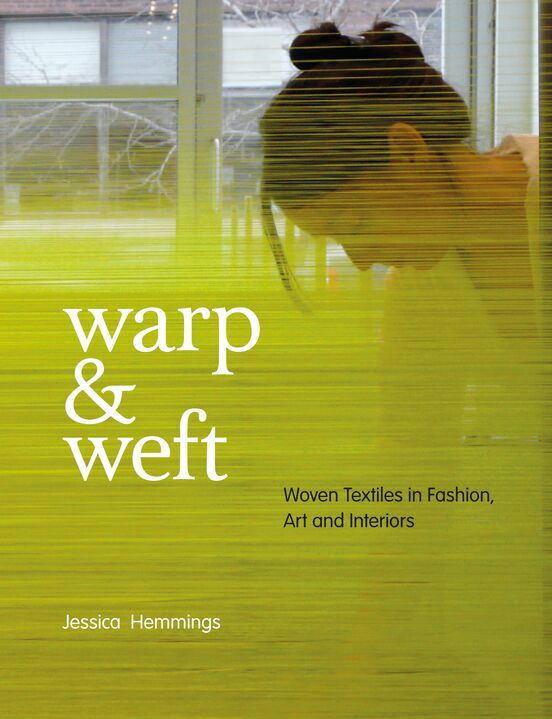
Figure 3. Warp & Weft: Woven Textiles in Fashion, Art & Interiors (Bloomsbury: 2012) book cover.
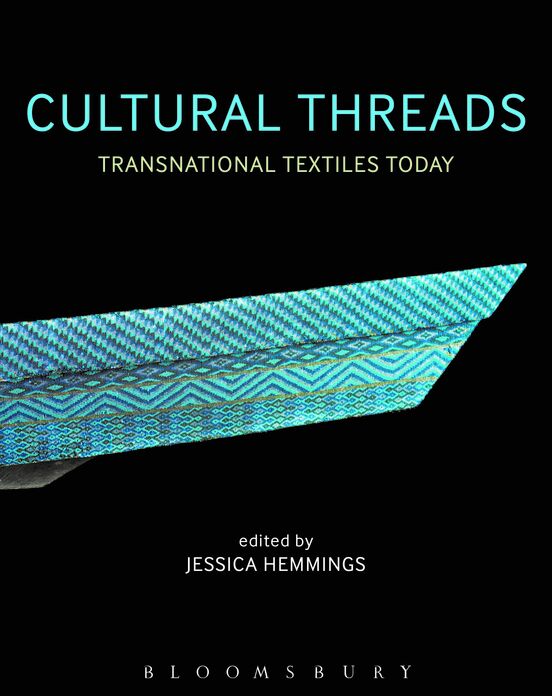
Figure 4. Cultural Threads: Transnational Textiles Today (Bloomsbury: 2015) book cover.
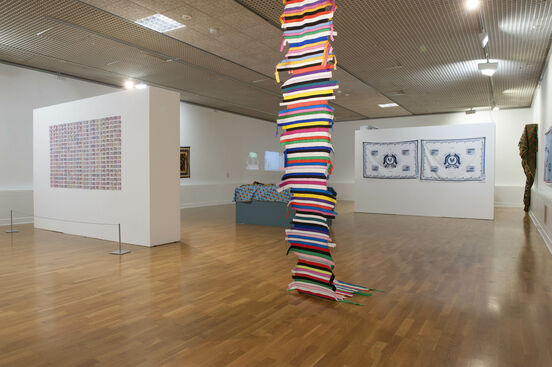
Figure 6. Migrations exhibition installation view Huddersfield Art Gallery (October 22, 2016 – January 21, 2017). Featuring work by Francoise Dupre, Claire Barber, Toril Johannessen and Mr Somebody & Mr Nobody
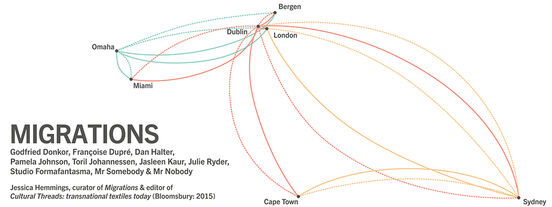
Migrations exhibition poster mapping routes of material travelled.